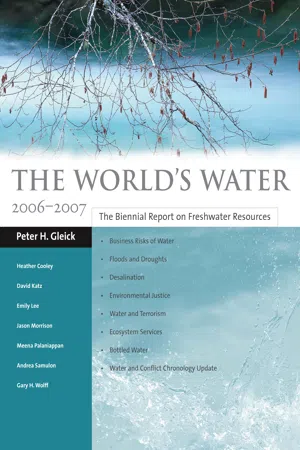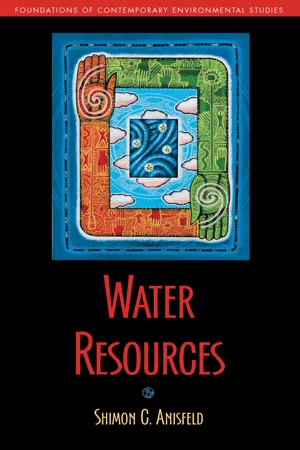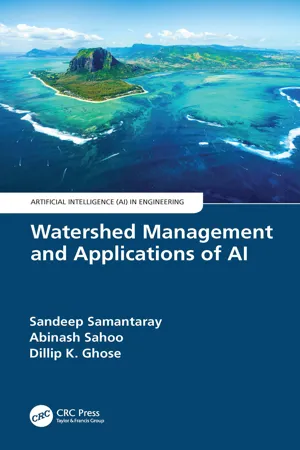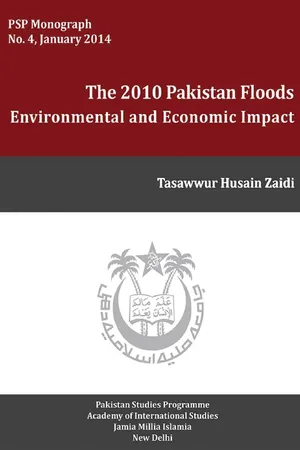Floods
Floods are natural disasters characterized by the overflow of water onto land that is usually dry. They can result from heavy rainfall, snowmelt, or the overflow of rivers and oceans. Floods can cause extensive damage to infrastructure, homes, and agriculture, and pose significant risks to human life and safety.
6 Key excerpts on "Floods"
- eBook - ePub
The World's Water 2006-2007
The Biennial Report on Freshwater Resources
- Peter H. Gleick, Gary H. Wolff, Heather Cooley, Meena Palaniappan, Andrea Samulon, Emily Lee, Jason Morrison, David Katz(Authors)
- 2013(Publication Date)
- Island Press(Publisher)
...2005). Floods Definition Floods are more easily defined and classified than droughts, and their effects are more obvious and visible. A flood is defined as “the rising of a body of water and its overflowing onto normally dry land” (Princeton University 2005). Four primary flood types are categorized according to where they occur. As these categories indicate, Floods can occur in a range of environments. These flood types are described in greater detail: Coastal flood. Inundation of coastal land above normal tide levels due to storm surges or wave action. Strong winds from hurricanes or tropical storms can push water inland. Geologic events, such as earthquakes, landslides, or volcanoes, can cause tsunamis with potentially devastating effects in coastal areas. River flood. Inundation of land along a riverbank due to a river or stream overflowing natural, or constructed, confines. River Floods occur on timescales of hours to weeks, as precipitation occurs in excess of that needed to recharge groundwater. Warm rain on top of snow pack can be particularly dangerous. In coastal areas, river Floods can be exacerbated by high tides, which slow drainage. Urban flood. Flooding that occurs on relatively short time periods when insufficient drainage is available to remove precipitation. Paved surfaces prevent soil infiltration of water, leading to rapid runoff into storm sewers, drains, and local creeks in excess of their ability to transport water. Inadequate storm drainage systems can also induce flooding. Basements and low points are at particular risk. Flash flood. Typically a highly localized, rapid event that is more common in arid and desert areas. Flash Floods are caused by high precipitation levels and are often associated with thunderstorms or other tropical storms. Dam breaks, or even an ice break, can also induce a flash flood...
- eBook - ePub
- Shimon C. Anisfeld(Author)
- 2011(Publication Date)
- Island Press(Publisher)
...4 Water, Water, Everywhere: Dealing with Floods Although water scarcity problems tend to dominate water management (and this book), too much water can also be a problem. In this short chapter, we discuss various aspects of the flooding problem. We begin with definitional issues, then look at trends in flooding impacts, and finally discuss flood management and ways to reduce our vulnerability to Floods. The discussion of Floods will continue in Chapter 6 in the context of land use and climate change, and in Chapter 8 in the context of the “urban stream syndrome.” 4.1. Defining Floods Floods are unusually high water levels that cause the inundation of what we normally think of as dry land. Floods can be classified into three types: • River Floods: When the flow of water in a river is larger than the capacity of the channel to convey it, the river will overflow its banks and inundate its floodplain. • Urban Floods: Stormwater flow in urban areas is often highly modified by land use and by a network of storm sewers meant to convey rainwater to streams. During rainfall events, flooding can occur along urban streams or streets or in people's basements. Backups of storm or sanitary sewer lines are also common. • Coastal Floods: Coastal storm surges can lead to flooding with sea-water, driven primarily by high winds in a landward direction, often combined with high tides. This was the case, for example, with the flooding of New Orleans by Hurricane Katrina in 2005. Precipitation is obviously a key factor in noncoastal flood events. High-intensity short-duration events extending over small areas (thunderstorms) can result in rapid stormflow and can cause short-term flooding in small streams, especially in urban areas. In contrast, flooding in large rivers typically lasts longer and is caused by rainfall of longer duration and greater spatial extent...
- eBook - ePub
- Sandeep Samantaray, Abinash Sahoo, Dillip K. Ghose(Authors)
- 2021(Publication Date)
- CRC Press(Publisher)
...7 Flood and Drought 7.1 Introduction Flood is an unusual high-water stage in a river, generally the level at which water overflows its natural and artificial banks and submerges land which is usually dry. Occurrence of Floods results in significant damages in terms of property loss, loss of lives, and financial loss because of disturbance in economic activities, which are all very well known. Every passing year crores of rupees are spent on flood forecasting and flood control. For hydrologic design purposes, hydrograph of extreme flood events and stages in correspondence to peak flood provides significant data. Furthermore, amongst different flood hydrograph characteristics, probably the most vital and broadly applied parameter is flood peak. Flood peak fluctuates year by year and its magnitude comprises a hydrologic series that enables one to allocate a frequency to a specified value of flood peak. Practically for designing all hydraulic structures, expected peak flow with a given frequency (1 in 100 years) is of major significance for effectively proportioning the structures for accommodating its influence. Designing of spillways for dams, culvert waterways, and bridges and estimating scour depth at any hydraulic structure are few instances in which flood peak values are necessary. For estimating a flood peak magnitude, alternative approaches are given below: Rational formula Empirical formula Flood frequency analysis Utilization of a specific technique depends on (i) desired objective; (ii) availability of data; and (iii) significance of project. In addition, rational formula is simply appropriate for small-size (<50 km 2) watersheds and unit-hydrograph approach is usually limited for moderate-sized (< 5000 km 2) watersheds. 7.2 Rational Formula A rainfall of very long duration and uniform intensity happening over a basin is considered...
- eBook - ePub
Floods and Drainage
British Policies for Hazard Reduction, Agricultural Improvement and Wetland Conservation
- Edmund Penning-Rowsell(Author)
- 2019(Publication Date)
- Routledge(Publisher)
...Historical flood records have been investigated and attempts made to incorporate these data, which are often qualitative in nature, into flood analysis to augment those obtained from hydrometric surveys (Potter 1978). Data alone, however, are of limited value. The development of satisfactory analytical techniques has long been recognised as being vital. As Howe et al. (1967) observed, ‘the history of the study of Floods is essentially the record of a search for adequate tools to analyse past hydrological events in terms of future possibilities of occurrence’. Similarly, the report on Flood studies for the United Kingdom (Institution of Civil Engineers 1967) emphasises that ‘one of the most difficult problems in flood hydrology is the interpretation of recorded events to derive estimates of the future probabilities of events of different sizes’. Just as the raw hydrological data has been improved in recent years so has research in Britain and elsewhere provided a wider range of more sophisticated analytical techniques. Research on flood magnitude and frequency As physical phenomena, in contrast to their hazardous effects, Floods have been described as both three-dimensional and binary (Howe et al. 1967). Floods are binary in that they are most influenced by two sets of factors: climatic and physiographic. Various studies have been undertaken to identify the relationships between these factors and flood characteristics, many involving multiple regression techniques designed to isolate the contribution different parameters make to peak flows (Potter 1961, Benson 1962, Rodda 1969). The three-dimensional nature of Floods derives from their three significant characteristics, namely magnitude, frequency and timing...
- eBook - ePub
The 2010 Pakistan Floods: Environmental and Economic Impact
Environmental and Economic Impact
- (Author)
- 2015(Publication Date)
- KW Publishers(Publisher)
...A major flood struck the country in 2003 and devastated many properties resulting in a loss of more than US $ 5 billion. Between 2001 and 2007 more than 1,950 persons lost their lives. Except properties and lives, the loss to environment by Floods has been far more incalculable. Pakistan had barely recovered from the destruction of the 2005 earthquake when in 2010 it was worst hit by deadly and widespread Floods which left the country even more vulnerable to future Floods and other hazards (Table 2). In recent years, rising incidence of loss of life and property also indicates relative un-preparedness of governments and their institutions to deal with such hazards. Causes of Floods in Pakistan There are many hydro-meteorological, anthropogenic and geomorphologic causes of Floods in Pakistan. Some of them include heavy and concentrated rainfall in the river catchments augmented by snowmelt flows; siltation and obstructions, levees burst and spillover, surface gradient, river basin shape and size, etc. (Figure 6). In the upper part of the Indus, floodwater spilling over the riverbanks generally returns to the river. However, in its lower part in Sindh it generally flows at a higher elevation than adjoining lands, the spill flows do not return to the river and cause Floods and damages. Breaches of river embankments often cause greater damage than would have occurred without the bunds because of their unexpected nature and intensification of land use. The inadequate existing discharge capacity of some of the important structures (barrages and rail or road bridges) on the Indus, Chenab and Ravi is also one of the major reasons for flooding. The encroachment of settlements in riverine areas has also increased the quantum of flood damages and losses to humans and livestock...
- eBook - ePub
- Dina Ionesco, Daria Mokhnacheva, François Gemenne(Authors)
- 2016(Publication Date)
- Routledge(Publisher)
...Human activities may also result in sudden-onset disasters, such as nuclear or industrial accidents, flash Floods resulting from sudden water release from dams, or landslides associated with construction projects, all of which can have grave effects on communities. As the world's population increases, a growing number of people live in areas prone to hazards, whether sudden or slow onset, All geographic regions and localities experience some or other type of environmental change or stress; but some areas are particularly disadvantaged, both in terms of exposure of population and key infrastructures and assets to hazards, as well as in terms of local capacity to respond to adversity and to recover from disasters, which is often more limited in lower income countries. Climate change Greenhouse gas emissions from human activities since the nineteenth century have had a significant impact on the climate and weather systems. The development of transport, industry and new technologies reliant on fossil fuels, intense extraction of natural resources, mass deforestation and greater agricultural production to feed the growing population of the planet have all contributed to increasing the amount of carbon dioxide, methane and other gases released into the atmosphere, leading to its warming at an unprecedented rate. Climate change is now considered unequivocal by scientists, and is associated with increased global air and sea temperatures, changing precipitation patterns, melting glaciers and permafrost, the acidification of oceans, rising sea levels, and the growing frequency and intensity of meteorological, hydrological and climatological hazards. These changes inevitably disturb ecological, social and economic systems, exacerbating existing vulnerabilities, and affecting livelihoods, human security and human rights...





